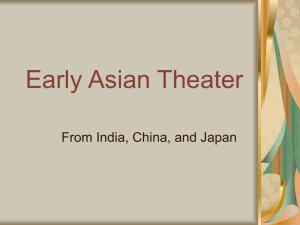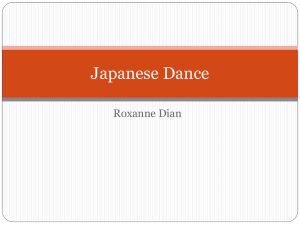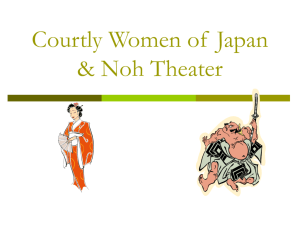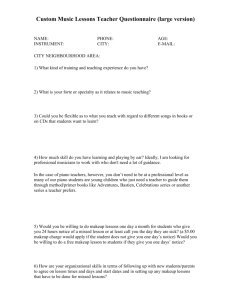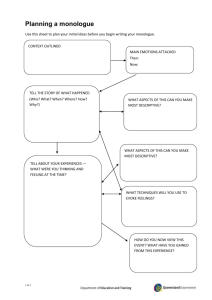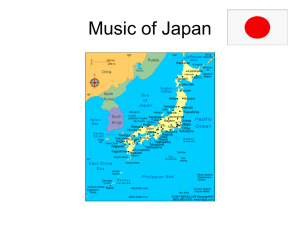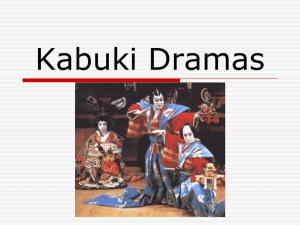Eastern Theatre.Japan Theatre Unit of Lessons
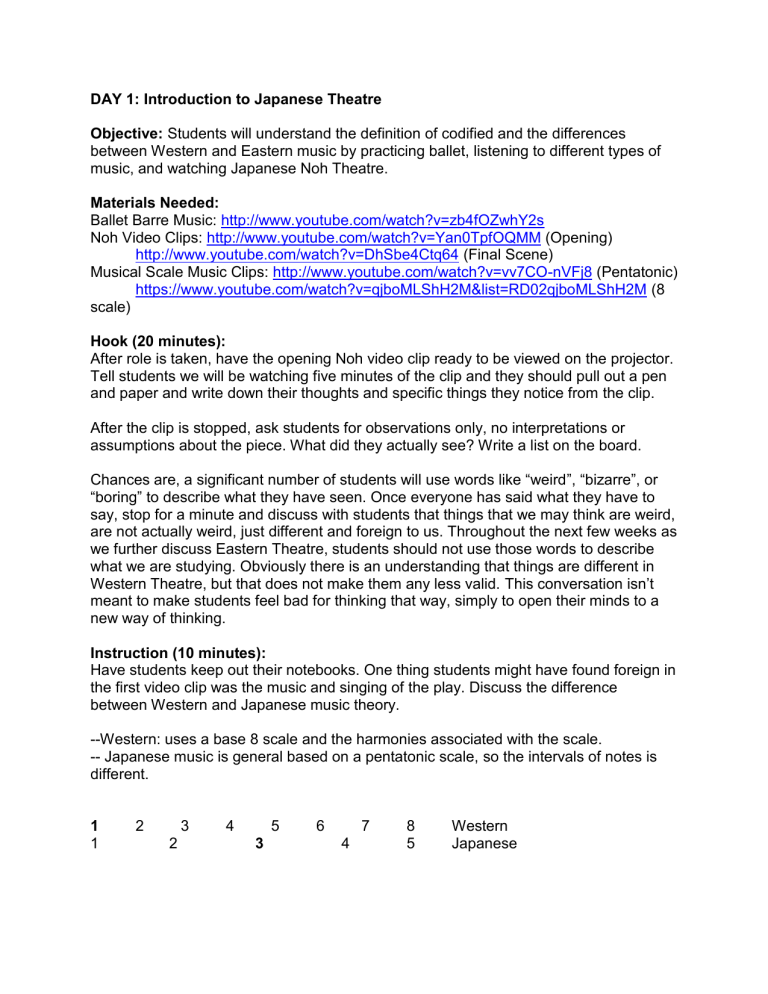
DAY 1: Introduction to Japanese Theatre
Objective: Students will understand the definition of codified and the differences between Western and Eastern music by practicing ballet, listening to different types of music, and watching Japanese Noh Theatre.
Materials Needed:
Ballet Barre Music: http://www.youtube.com/watch?v=zb4fOZwhY2s
Noh Video Clips: http://www.youtube.com/watch?v=Yan0TpfOQMM (Opening) http://www.youtube.com/watch?v=DhSbe4Ctq64 (Final Scene)
Musical Scale Music Clips: http://www.youtube.com/watch?v=vv7CO-nVFj8 (Pentatonic) https://www.youtube.com/watch?v=qjboMLShH2M&list=RD02qjboMLShH2M (8 scale)
Hook (20 minutes):
After role is taken, have the opening Noh video clip ready to be viewed on the projector.
Tell students we will be watching five minutes of the clip and they should pull out a pen and paper and write down their thoughts and specific things they notice from the clip.
After the clip is stopped, ask students for observations only, no interpretations or assumptions about the piece. What did they actually see? Write a list on the board.
Chances are, a significant number of students will use words like “weird”, “bizarre”, or
“boring” to describe what they have seen. Once everyone has said what they have to say, stop for a minute and discuss with students that things that we may think are weird, are not actually weird, just different and foreign to us. Throughout the next few weeks as we further discuss Eastern Theatre, students should not use those words to describe what we are studying. Obviously there is an understanding that things are different in
Western Theatre, but that does not make them any less valid. This conversation isn’t meant to make students feel bad for thinking that way, simply to open their minds to a new way of thinking.
Instruction (10 minutes):
Have students keep out their notebooks. One thing students might have found foreign in
1
1 the first video clip was the music and singing of the play. Discuss the difference between Western and Japanese music theory.
--Western: uses a base 8 scale and the harmonies associated with the scale.
-- Japanese music is general based on a pentatonic scale, so the intervals of notes is different.
2
2
3 4
3
5 6
4
7 8
5
Western
Japanese
-- While in Western music, the first note is our base note, in Japanese music, the 3 rd note is the base note bringing balance to the scale.
-- Listen to the two different music clips of the 8 note and pentatonic scales. After students listen to them, discuss how our ear has been trained to only hear the notes on our scales. Anything in between those notes sounds “off”. But nothing is wrong with it— it’s just different.
Instruction (5 minutes):
One of the other unfamiliar aspects of the first clip is the movement of the actor. He hardly seems to be doing anything at all. Tell students Noh Theatre is a dance style that is considered “codified”.
Define Codified with the students. Write it on the board.
-- arranging a systematic form or code.
What other things do we have in Western Society that are codified? Ballet!
Practice (30 minutes):
Ask a student who has several years ballet experience to come up and show the class a simple ballet combination. (If there is a second student in the class who can do ballet, have Student 1 do the combo while Student 2 closes their eyes. Then switch. Simply by hearing the same instructions, both students should be able to do the exact same movements.
Now everyone is going to learn some ballet.
Start with 20 jumping jacks and a jog around the room to get everyone’s blood pumping.
Teach students simple ballet moves: plies, tendus, degages, rond de jambe
When students have sufficiently mastered the skills, turn on the youtube clip and have them all practice to music.
Instruction: (15 minutes)
Have students get their chairs back and face the board. What was that experience like?
Easy? Difficult? What differences did you notice between students who have and have not had ballet training?
Noh Theatre is codified. Watch the second video clip of Noh Theatre, and afterwards discuss again the observations of the students. Now that they understand music theory a little bit more, and know how much work it takes just to master simple movements, hopefully they can better understand and appreciate Japanese Theatre.
Lesson 2
—Noh Theatre
Objective: Students will understand the emotional and symbolic nature of Noh theatre by reading Atsumori and discussing Noh concepts.
Materials Needed:
- one copy per person of Atsumori
Hook: (10 minutes)
Last time we looked into the basics of Noh Theatre and had questions about how many actors were actually in Noh plays. Turns out that even though we only saw clips with one actor, there are at least three actors in every Noh play. Discuss the following character types with the students.
Instruction: (30 minutes)
Noh Character Types
Shite.
In plays where the shite appears first as a human and then as a ghost, the first role is known as the maeshite and the later as the nochishite.
Shitetsure.
The shite's companion.
Waki performs the role that is the counterpart or foil of the shite.
Wakitsure is the companion of the waki.
Kyōgen perform the aikyōgen interludes during plays. Kyōgen actors also perform in separate plays between individual noh plays.
Hayashi, or hayashi-kata, are the instrumentalists who play the four instruments used in
Noh theater: the transverse flute, hip drum, the shoulder-drum, and the stick-drum. The flute used for noh is specifically called nōkan or nohkan.
Jiutai is the chorus, usually comprising six to eight people.
A typical Noh play always involves the chorus, the orchestra, and at least one shite and one waki actor.
Once you feel the students have a basic knowledge of all the characters, have the students bring four chairs into a square at the front of the room. Tell students that they are now going to learn how a Noh audience immediately knows who each character is the second they walk on stage solely based on where they’re standing. Discuss with students for 4 pillars of Noh.
Stage Direction: 4 Pillars of Noh the waki-bashira in the front, right corner near the waki's standing/sitting points. the shite-bashira in the rear, left corner, next to which the shite normally performs. the fue-bashira in the rear, right corner, closest to the flute player. the metsuke-bashira , or "looking-pillar", so called because the shite is typically faced toward the vicinity of the pillar.
Now we’re going to read a Noh play called Atsumori. We are going to split into groups of three. In Atsumori there are three characters: the shite, the waki, and the kyogen. The kyogen is not in the majority of the scenes, the person reading the kyogen will also need
to read the stage directions written in the script. This is very important. As we saw yesterday, Noh movements are hugely significant in the play, and since movements are codified these same stage directions will be applicable every time this show is produced.
Practice: (15 minutes)
Read Play
Discussion: (10 minutes)
What did you notice about the play?
Did you find anything interesting about the characters?
Did you agree that reading the stage directions was important?
Were you able to visualize the play from reading it? Why or why not?
How is this play different in structure from the realism plays we are used to?
Instruction: (10 minutes)
Noh plays fall into several different categories:
Noh Play Types
1. Kami mono or waki nō
typically feature the shite in the role of a human in the first act and a deity in the second and tell the mythic story of a shrine or praise a particular spirit.
2. Shura mono or ashura nō ( warrior plays) have the shite often appearing as a ghost in the first act and a warrior in full battle regalia in the second, re-enacting the scene of his death.
3. Katsura mono ( wig plays) or onna mono (woman plays) depict the shite in a female role and feature some of the most refined songs and dances in all of Noh.
4. There are about 94 "miscellaneous" plays, including kyōran mono (madness plays), onryō mono (vengeful ghost plays) and genzai mono (plays which depict the present time, and which do not fit into the other categories).
5.
Kiri nō (
final plays) or oni mono (demon plays) usually feature the shite in the role of monsters, goblins, or demons, and are often selected for their bright colors and fast-paced, tense finale movements.
What type of play do you think Atsumori falls into? Why? What if you were to classify
The Wiz into a category? Which would you choose? Why? Leads into…. Final project discussion!
Discussion: (10 minutes)
For your final performance for this unit, you will be performing a monologue. Obviously, we understand you can’t really perform a Noh monologue in Japanese because it takes years to master all of the techniques used within the artform. So, instead, each student will be selecting an American Realism monologue, then every day as we discuss more elements of Japanese Theatre, we will also add elements to the final list of things you need to present with your final monologue. Some will be written assignments, and some
will need to be presented in the final monologue. Start making a list. Here are the things we learned today that will be incorporated into the final monologue.
- Written: One paragraph describing the type of Noh play category your American
Realism play would fall into. Obviously, it will not exactly match the description, but all you need to do is select one area and accurately defend it. As long as you defend a logical decision, you will get full points.
- Written: One paragraph describing the type of Noh character your American realism character would fall into. Same argument approach applies here.
- Performance Element: Noh Blocking. Based on what type of character you are and who you are talking to within your monologue, you need to decide where you will be standing and looking according to the four pillars of Noh.
If students need an example, continue on with the Wiz theme and categorized the
Scarecrow into a character type and where he might stand on the stage and why.
Lesson 3
—Introduction to Kabuki (Assembly Schedule 70 minutes)
Objective: Students will gain a basic understanding of Kabuki as an art form by creating a Kabuki mie.
Materials Needed: Youtube clips http://www.youtube.com/watch?v=aPg5XWIexMk&list=PL11BEBFF4345279C9 (3:30-
4:50) http://www.youtube.com/watch?v=hlTQUzPZU8Y (watch whole thing)
Hook: (5 minutes)
Watch first clip —this is Kabuki. Kabuki originated from Noh theatre, however, there are some distinct differences. The idea of spectacle became very significant in Kabuki. It was the first pop culture theatre to come out of Japan. People had favorite actors and came to see shows with big dance numbers. While it is still very traditional and codified, there is a more relaxed nature in Kabuki versus Noh.
Instruction: (15 minutes)
Watch second video clip. When clip has finished, explain to students that we will be discussing Kabuki makeup next class period. Aside from makeup, what are other things you learned?
Things to mention:
- kanji (sing, dance, skill)
- originally very avant garde
—done by women, taken over by men
- elements of mie
- storytelling techniques (interaction with audience)
- only lit by candle
Instructions: (10 minutes)
We are going to create a mie for each of us to do practice on today. Each person needs to pick a cartoon or animated character. This cannot be a real person. Animated. Okay?
We are going to split up into groups of three. Try and pick partners that you haven’t been with before. In your groups of three, you are all going to make sure you haven’t different characters. Then, following the three steps of mie, you are going to create mies for each of your characters. When we come back together, each group is going to write their three characters on the board, perform their mies, and we are going to guess which character belongs to which mie.
Practice: (10 minutes)
Students only have 10 minutes to go and create their mies. Students need to run back to their seats when the 10 minutes are up. Select one spokesperson to write all three characters on the board when you group is called.
Performance: (15 minutes)
Ask for volunteers of who would like to go first, then start picking people if there are no volunteers. Instruct students to wait until all three people have finished performing their mies before you guess their character.
Discussion: (15 minutes)
How easy/difficult was it to guess the characters?
What parts of the mie most helped us realize who the character was?
What do we know about each of these characters that was manifested in the physical nature of the mie?
What are other ideas of things people could have used to accentuate the characters?
How does this apply to the characters you are choosing for your monologue?
Final Note: Added to your final performance from today:
- Performance Element: Kabuki mie. It needs to include all three parts of the mie and the pause afterwards for dramatic effect. Remember, while you are using an American
Realism monologue, your performance is not realism based!!!! Don’t try and make a mie realistic. It should be exaggerated.
Lesson 4
—Kabuki Makeup
Objective: Students will understand the importance and meaning behind kabuki makeup by applying makeup to themselves and designing a makeup design sheet for their monologue character.
Materials Needed:
- Enough large mirrors for the class to see themselves.
- Kabuki makeup (made from finger paint and Crisco)
- 1 paintbrush per student
- popsicle sticks to dish out makeup
- face cleaning wipes
Hook : (5 minutes)
Mie: Mie’s are historically performed at the most climatic moment of a scene and/or play.
Review the different things that need to be included that we have discussed so far for the final monologue.
Instruction : (20 minutes)
Tell students we will be spending the majority of class today working on creating a
Kabuki makeup design for their characters. Review the basic ideas of kabuki makeup — accentuated eyes, nose, and mouth.
Show pictures of kabuki makeup. When students are creating their own makeup designs, they should not focus on making pictures on their faces that match their character, but think of ways they can use lines, just like in traditional kabuki makeup to express their character.
Makeup Application: For many actors in Western theatre, they take time to prepare themselves to enter the role
—kabuki actors do the same thing, but it is ritualized—when kabuki actors put on their makeup, it is a private and personalized experiences.
Normally, kabuki actors do not let other people watch as they put on their makeup before a performance.
Practice : (50 minutes)
We’re going to put on makeup today! The purpose behind putting on the makeup is so that you can see what certain lines do to accentuate your face. Drawing it on a picture won’t help if you don’t know the canvas you’re actually working on.
Each student will be given cups to put their makeup in and one paintbrush. They can experiment for the remainder of class, but two things need to happen —don’t get any paint on anyone else. Keep your hands and paintbrushes to yourselves. Two, by the end of class, students need to have a sketched out makeup design for their monologue character. They can color it at home.
Questions you should ask yourselves while you’re experimenting with the makeup:
- Is my character good or bad?
- What personality traits would I associate with my character?
- How does my character use his/her eyes to express themselves?
- How will the makeup around my mouth change as I talk?
Assessment : 15 minutes before class ends, have students start cleaning up. All trash should be thrown away, and then they need to come sit in a chair or on the floor. In the last 5 minutes of class, students need to start writing a paragraph explaining how and why the makeup they chose fits their character. This paragraph and the makeup design sheet will be turned in the final day when the students perform their monologues.
Final Note: Added to your final performance from today:
- Handed In: A final draft of the makeup design sheet, fully colored and neat looking.
- Written: A one paragraph description of why you chose the colors and shapes present in your makeup design.
Lesson 5: Bunraku
Objective: Students will understand the basic concepts of Bunraku through class discussion and performing a small skit using a four-man human puppet team.
Materials Needed:
Youtube videos
Video #1 http://www.youtube.com/watch?v=f4G68civvo8
Video #2 http://www.youtube.com/watch?v=T-fhUne-KnA (start at 1:35)
Video #3 http://www.youtube.com/watch?v=4TKt67ouaqM (start at 1:45)
Hook: (10 minutes)
Introduce Baby Teacher Big Mouth Puppet to the class. Have her say hello. Baby
Teacher is a big mouth puppet which means her mount is controlled by the thumb and four fingers flapping together and apart. Take apart the puppet and show the thumb hole and finger compartment.
Invite two students up to help with the puppet. Have one student be in charge of the head and mouth movement, while the other student is in charge of moving the arms.
Ask another student in the class to come up with a line of dialogue they want the puppet to say. Once the class has decided on a line, have the person who came up with the line say it, while the two volunteers move the puppet to react to the line.
Ask the volunteers how difficult it was to match the movement and emotion of the line of dialogue. If time permits, a second team of students can try.
Instruction: (40 minutes)
Show pictures of bunraku puppets. Obviously, these puppets are significantly more complex than Baby Teacher. There are two types of Bunraku puppets.
Osaka: smaller sized puppets
Awaji: bigger
We will learn about them in this video!
Watch first video. (10 minutes included in the 40)
Discuss what was seen in the video and clarify the different types of puppeteers. \
The main puppeteer, the omozukai , uses his or her right hand to control the right hand of the puppet.
The left puppeteer, known as the hidarizukai or sashizukai , depending of the tradition of the troupe, manipulates the left hand of the puppet with his or her own right hand by means of a control rod that extends back from the elbow of the puppet.
A third puppeteer, the ashizukai , operates the feet and legs.
Puppeteers begin their training by operating the feet, then move onto the left hand, before being able to train as the main puppeteer. This process can take 30 years to progress.
Watch second video (This video is footage of a bunraku performance. Have students pay special attention to the life-like qualities of the puppets.)
There are two other important people in a Bunraku performance. They are the TAYU and the SHAMISEN. The Tayu is the voice of the characters. The shamisen is the instrumentalist.
Usually a single chanter recites all the characters' parts, altering his pitch in order to switch between various characters. However, sometimes multiple chanters are used.
The chanters sit next to the shamisen player on a revolving platform, and from time to time, the platform turns, bringing replacement musicians for the next scene.
The role of the tayu is to express the emotions and the personality of the puppets. The tayu performs not only the voices of each of the characters but also performs the voice of the narrator.
Located to the side of the stage the tayu physically demonstrates facial expressions of each character while performing their respective voices. While performing multiple characters simultaneously the tayu facilitates the distinction between characters by exaggerating their emotions and voices. This is also done to maximize the emotional aspects for the audience.
The shamisen used in bunraku has a sound which is different from other shamisen. It is lower in pitch, and has a fuller tone.
Watch third video (This video shows the tayu and shamisen during a performance).
Practice: (20 minutes)
Students are now going to practice their own puppeteering skills. Split class into groups of 4 (it is better to have a group of 5 than a group of 3). Students will each be one of the puppeteers or the puppet itself. One in charge of head/right arm, one in charge of left arm, one in charge of feet, and one puppet. (If 5 in group, split the head and right arm controls).
Each group is going to do a miniskit of the “day in the life of a Bunraku puppet”. They can either be backstage or on an adventure around the world as a puppet in a human world. Give the students 15-20 minutes to make their skit, then come back together as a group.
Assessment: (10 minutes)
Have each of the groups perform their skits.
Discussion: (10 minutes)
Have students discuss what they learned in being puppeteers/puppets (try to focus more on the viewpoints of the puppeteers). What was challenging? How did three different manipulators influence the way one puppet moved? Imagine an actual Bunraku puppeteer who has to use individual fingers simultaneously to create various movements at the same time. How much more difficult do you think that would be?
One of the most interesting things about Bunraku is the number of years required to become proficient in puppeteering. Don’t give up on challenges in your life just because you gave it a few tries and it’s not working. Becoming an artist takes TIME, EFFORT, and FOCUS.
Final Note: Added to your final performance from today:
-
Performance Element: You will need to include a “mood change/head flip” as we saw in the youtube clip with the demon puppet. This does not mean your character must be a demon, but at a significant moment when the objective or tactic changes for your character, we need to see a dramatic mood swing accentuated with facial expressions and vocal changes before and after you flip your head to the ground and back up again.
Lesson 6: Butoh
Objective: Students will gain an understanding of the complexity of meaning in Butoh body movements by studying Butoh film and practicing Butoh in order to incorporate two movement pieces to their final monologue.
Materials Needed:
3-4 different songs for hook (various styles
—anything works) http://www.youtube.com/watch?v=NdwL27NzIVg (excerpt stop at 3:35) http://www.youtube.com/watch?v=AnR1FJ6yQq4 (4 men) images of Butoh dancers
Hook: (5 minutes)
Have music on when students enter the classroom. Pick several songs in different styles with completely different feels. When class starts, have students get up and start moving to the music however they want.
(Side coaching: Think about what you’re communicating with the way you’re moving your body. What would other people be thinking about after watching that movement.)
Instruction: (30 minutes)
Before First Video:
Butoh loosely translated means stomp dance, or earth dance.
The other issue this raises is that the audience cannot usually discern what this internal image is - nor should it. Good Butoh is like a Rorschach test. The audience reads their own story in the actions
Watch Sankai Juku Clip
Butoh is strange, dark dance form created by Hijikata Tatsumi in Japan during the years following World War II. Butoh is defined by i ts very evasion of definition. “Hijikata’s dance was literally called Ankoku Butoh,” he said, “meaning black or dark dance . The darkness referred to elements — the territory of taboo, the forbidden zones — on which light had never been cast… It is both theater and dance, yet it has no choreographical conventions. It is a subversive force, through which conventions are overturned. As such, it must exist somewhere on the social periphery… It is a force of liberation, especially within the conformist Japanese social structure…”
In Butoh there is a strong element of Hiroshima and Nagasaki. The Atomic bomb devastated Japan, but the consciousness of humanity was held hostage. The impossible was now possible; complete and utter annihilation. It is the feeling of a silent scream, which sometimes underscores Butoh.
One is the concept of the empty body . This refers to an opening up of space in the body to allow yourself room to be moved. To move without conscious intention or desire for self-expression.
Hijikata believed that by distorting the body, and by moving slowly on bent legs he could get away from the traditional idea of the beautiful body, and return to a more organic natural beauty. The beauty of an old woman bent against a sharp wind, as she struggles home with a basket of rice on her back. Or the beauty of a lone child splashing about in a mud puddle - this was the natural movement Hijikata wanted to explore. Hijikata grew up in the harsh climate of Northern Japan in an area known as
Tohoku. The grown-ups he watched worked long hours in the rice fields, and as a result, their bodies were often bent and twisted from the ravages of the physical labor.
These were the bodies that resonated with Hijikata. Not the "perfect" upright bodies of western dance, or the consciously controlled movements of Noh and Kabuki. He sought a truthful, ritualistic and primal earthdance.
Watch 4 men Clip
One that allowed the performer to make discoveries as she/he created/was created by the dance.
Discussion: (5 minutes)
What is your first reaction to Butoh?
What do the movements look like/mean to you?
What are the similarities and differences of Butoh from Noh, Kabuki, and Bunraku?
Activity: (10 minutes)
Split class up into groups of 3. Each of them gets one of the following social issues:
Global Warming
Drug Abuse
Poverty
Women's Rights
Environmental Pollution
Eating Disorders
Unemployment/Homelessness
Students need to come up with a 20-30 second dance to present to the class
Performance: (15 minutes)
Discussion: (15 minutes)
Ask students different ways they might incorporate Butoh into their monologues.
Have students turn to the person next to them and brainstorm ways they can incorporate movement into their particular monologue.
If students seem to be struggling, point out specific moments from the social issue performances that are good examples of how to incorporate movement.
If students feel they have a good grasp on what they would like to do to incorporate
Butoh, the rest of class can be given for rehearsal time.
Final Note: Added to your final performance from today:
- Performance Element: You will need to include TWO stylized movements in your performance. These should be well above and beyond anything we might possibly see in a realism performance. Go big or go home.
Lesson 7
—Workshop
Objective: Students will demonstrate their ability to incorporate exaggerated body movements by participating in group exercises and writing out final performance specifics.
Materials Needed : none
Hook: (5 minutes)
Have students take three minutes to run around the room and get their body warm. Tell students you will count down the last twenty seconds and then they should be standing in a circle at the front of the classroom quietly.
Instruction: (10 minutes)
Tell students that today we are going to be playing some games. These games are variations of games from the fabulous Viola Spolin who is really great at helping us get into the bodies and minds of our characters.
The first game we are going to do is called Who Am I?. We are going to send one person out of the room and then decide who they are. When they come back in, we are not going to pantomime so that they can guess who they are; we are going to be other people in their environment that they might normally interact with.
Rule #1: Interact with them as if they know who they are, don’t show them what they should be doing.
Rule #2: Pick general characters like doctor, zombie, or dinosaur. Don’t make it a specific celebrity or other person.
Rule #3: Don’t stop the activity until I say stop and ask you who you are.
Practice: (20 minutes)
Ask for volunteers of who would like to leave the room. Facilitate picking a good character after they have left. Call the person back in from the hallway. Students should immediately start interacting with them. Watch the first one without interacting in the scenario.
Facilitate a small discussion after each round, especially if there is needed clarification on the rules. Remind students to use their bodies!!! We need to be able to guess what you’re doing so use exaggerated movements to make your point.
Repeat the activity three or four times.
Discussion: (10 minutes)
How interesting was the activity?
How quickly were each of the people who went out able to guess?
Do you think that has anything to do with the amount we as other people in the environment used our bodies? (Specifically get opinions from people who left the room).
Did any of the exaggerated movements feel natural to you? Why?
Did anyone else’s exaggerated movements look natural to you? Why?
Instruction: (5 minutes)
Tell the students that now we are going to do a Spolin activity that focuses on controlling your reactions. I am going to start describing a scenario. You will be listening to the scenario as you walk around the room. React to the description. But again, you are not pantomiming what I say, you are experiencing it. This will be very important when you hear the rest of what will happen. After I start describing a scenario, there will be a distinct mood shift in what I am saying. However, you CANNOT RESPOND to the mood shift. As with rehearsed acting, we know a few lines before it happens that a revelation is coming for our character, but you can’t show us that you know it’s coming!
So, when I start talking about the mood shift, you need to continue to act as if the original scenario is still happening. Then, I will clap my hands and you will immediately switch to the changed situation/mood.
Remember. NO PANTOMIMING. If you start pantomiming, what are you going to do when I start describing the new mood shift? You can’t pantomime that because I haven’t clapped my hands yet. Make sense?
Practice: (20 minutes)
Ideas for scenarios: You are sitting in a park, sun is shining, everything is nice. Great fe elings. You sit down on a bench, everything’s great. Then you realize you sat on gum.
You try and scrape it off with a newspaper but then you smear ink on your pants. It starts raining. CLAP.
Repeat the activity two or three times.
Discussion: (15 minutes)
What in your final performances requires an emotional mood shift? Your Bunraku head flip!! But you can’t lead into the change in emotional state before the head flip. We need to see a distinct before and after in facial expression, the way you are holding your body, and your voice.
Lesson 8
—Previews
Objective: Students will demonstrate their ability to incorporate Japanese theatrical elements into an American realism monologue by rehearsing and performing a preview for the class.
Materials Needed: none
Hook: (5 minutes)
Have students stand up and push all their chairs away. Using the entire classroom, students need to run around the room at slow motion for three minutes as if they are running through molasses.
Side Coaching: How taunt are each of your muscles? How much energy does it take to push through? Your body should be getting very tired. How far away from your body do you need to extend your arms to pull yourself through the goo?
Remember: even though there isn’t actually anything there, our movements become exaggerated to show something that only our bodies can communicate. Get it!?
Instruction/Practice: (30 minutes)
Students will now divide up into groups of three. In each group, each student will perform their monologue and get feedback from their group members. Each person has
10 minutes for the performance, feedback, and any workshopping you would like to do in order to help your classmates.
Practice: (40 minutes)
Gather students back together and have them take a seat. Each student will now be performing for the whole class. Take volunteers and then call out names of students if no one is jumping up. Any tardy students get to be first if no volunteers are going. Give instructor feedback after each performance. Students should take notes on their own feedback and the feedback of their peers.
Conclusion:
Next time is final performances!!! These are the things that are due:
In your performance:
- one mie (Kabuki)
- one head flip (Bunraku)
- pillar blocking elements (Noh)
- two stylized movements (Butoh)
Written:
- one paragraph category of play (Noh)
- one paragraph charcter type (Noh)
- makeup design (Kabuki)
- one paragraph about makeup design (Kabuki)
Lesson 9
—Performances
Objective: Students will demonstrate their ability to incorporate Japanese theatrical elements into an American realism monologue by performing for the class.
Materials Needed: none
Hook: (5 minutes)
We are doing the same activity as yesterday FOR A REASON. Remember what it’s like to repeat the same movement and keep it just as exaggerated as the time before.
Have students stand up and push all their chairs away. Using the entire classroom, students need to run around the room at slow motion for three minutes as if they are running through molasses.
Side Coaching: How taunt are each of your muscles? How much energy does it take to push through? Your body should be getting very tired. How far away from your body do you need to extend your arms to pull yourself through the goo?
Keep your movements just as big in your performances!!!
Performance: (45 minutes)
Set up four chairs at the front of the room to be the four pillars around which students should center their blocking.
When students get up, they should hold up the picture of their makeup design and give their slate. Then students can set down their makeup design on one of the chairs and begin their performance. Make sure to say thank you at the end so we know you’re finished.
Discussion:
Discuss with students the different aspects of Japanese theatre and get their opinions on how they think they did in communicating those ideas. A lot of the “stylized movements” we saw were actually incredibly close to realism. What does that tell us?
While we may think big movements are crazy looking, they actually look very natural.
Be bigger in your every day performances of American Realism!
Type of Noh Play
Character Type
Kabuki Makeup
Design Sheet
Kabuki Makeup
Explanation
Noh Blocking
Movements
Kabuki Mie
Bunraku Mood Flip
Butoh stylized movement #1
Butoh stylized movement #2
Total Points
1
1
2
1
2
2
2
2
2
2
X
X
Design is neat looking with clear lines and colors drawn. The colors on the design sheet match the character description given in the explanation paragraph.
X
1
Explanation tells which of the Noh play types is chosen and answer is defended.
Explanation tells which character is chosen and answer is defended.
Design is turned in but is not colored. Lines may be somewhat neat but it is hard to tell what the design is supposed to look like.
Explanation is clear in describing what color goes on which part of the face and how it applies to the character.
Blocking properly uses the four corners of the stage. Actors have made clear choices in where they are standing and looking.
The mie is clear and has distinct foot, arm, and eye movements. The mie is done at a climactic moment in the monologue.
Head flip is present on a beat change.
There is a distinct emotion before the head flip that the audience has time to acknowledge and a distinct emotion after.
A distinct stylized non-realism based movement is added into the gestures of the scene. It conveys a message to the audience.
A distinct stylized non-realism based movement is added into the gestures of the scene. It conveys a message to the audience.
Blocking uses the four corners incorrectly and monologue is not given to one specific point/person.
The mie is present, but movements are muddled and it does not come at a climactic moment.
A head flip is present on a beat change. Not clear the emotional/tactic difference before and after the flip.
A stylized movement is present, but it seems more like a realismbased gesture than a stylized movement.
A stylized movement is present, but it seems more like a realismbased gesture than a stylized movement.
0
No explanation is given for the type of Noh play chosen.
No explanation is given for the type of character chosen.
Design not turned in, or turned in with little to no work done. Pencil only. Not complete. No telling where colors might have been.
No explanation is given, or explanation is written, but it does not tell why the colors were chosen or where they go on the face
Monologue has little to no blocking completely ignoring the pillars of Noh.
There is no mie present in the monologue.
There is no head flip on a beat change present in the monologue.
There is no stylized slow movements present.
There is no stylized slow movement present.
Lesson 10 —Paper
Objective: Students will demonstrate their ability to analyze and integrate Japanese theatrical elements into an American realism play by writing a comparison paper.
Materials Needed: none
Note: In grading these final papers, take into consideration the amount of time given to students to write the paper in determining generally how long the papers should be, but there is no set length requirement.
Instruction: (10 minutes)
Students have the entirety of class today to write a paper. The paper needs to include
TWO examples of the following:
- What element of Japanese Theatre can be incorporated into an American Realism play? Students should pick a play and how the element can be used within that play.
Example: Within the play, “The Life and Adventures of Nicholas Nickleby”, kabuki makeup design could be used to show how each of the 127 characters in the show are distinct individuals even though they are played by only 30 different people.
Then students can discuss how Kabuki makeup would assist in those character differences.
Performance: (60 or 80 minutes) The paper is due at the end of class. Ask for any other questions. Let the students begin.


